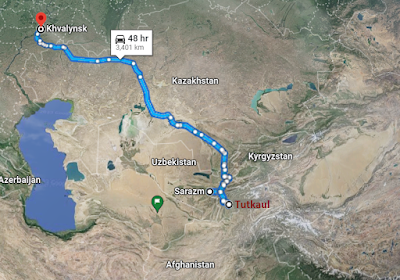Yu, He, 2022, "Paleogenomics of Upper Paleolithic to Neolithic European hunter-gatherers", https://doi.org/10.17617/3.Y1KJMF, Edmond, V2
The dataset for the above paper is available, but the paper/preprint is not. One of the samples is TTK001
 |
| Tutkaul, Sarazm, Khvalynsk locations |
qpAdm on this sample revealed that they possessed mainly ANE ancestry with additional Iran Neolithic component.
Target: TTK001
Russia_Kolyma_M.SG: 2.7 ± 2.7%
Iran_GanjDareh_N: 17.8 ± 3.1%
Russia_Kolyma_M.SG: 2.7 ± 2.7%
Iran_GanjDareh_N: 17.8 ± 3.1%
Russia_AfontovaGora3: 79.5 ± 3.2%
p-value: 0.065
Kocher, Arthur et al. “Ten millennia of hepatitis B virus evolution.” Science (New York, N.Y.) vol. 374,6564 (2021): 182-188. doi:10.1126/science.abi5658
Kocher et al, 2021 studied another sample from Tutkaul, Tajikistan with id TTK002. In their excel supplement, they list:
TTK002, B-n3, Tajikistan,Tutkaul, 38.3 69.3, Neolithic (Hissar culture), 6466-6077 cal BCE (GV-02104 7450 ±106)
“Tutkaul”, Tajikistan. (Individuals TTK002): The site of Tutkaul is located in southern Tajikistan, 70 km southeastwards of Dushanbe in the Dashti-Mazar region. The site was discovered during the archaeological survey of the Nurek dam’s flooding area led by A.P. Okladnikov in 1956 (106). Excavations were conducted during six field seasons (1963, 1965-1969) as part of a rescue archeological program led by the Tajik Archeological Expedition (107). The upper part of the stratigraphy consists of a medieval fortified settlement, followed by levels 1 and 2 which are attributed to the Hissar Neolithic culture. The lowest stratigraphic units (3 and 2a) belong to the Early and Late Epipaleolithic (108). At the base of level 2, three burials were identified containing the remains of four individuals: a female adult (burial nb. 1), a subadult (burial nb. 2) and two children (burial nb. 3). The burials were oriented to the SE-NW, the skeletons were in a bent condition on the left side, suggesting that the bodies were tied up before being buried. TTK002 is the 19 vertebra from a child found in burial nb. 3. An unidentified bone fragment from the same burial was radiocarbon-dated to 8425-8025 cal BP (GV-02104 7450±106).
TTK002 is confirmed to be from Tutkaul and dated to ~6200 BCE. We can assume that TTK001 is from one of the other 3 individuals.
Rough modelling of the ~3600-3300 BCE Tajikistan_Sarazm samples show 25% TTK001 ancestry, competing sources like Tarim_EMBA or Tyumen_HG are not chosen.
Some TTK ancestry is also seen in the Khvalynsk individuals, and it also explains the presence of Y HG Q in the Khvalynsk samples.
Some conclusions and questions:
1. Additional Iran N-related ancestry expanded into Tajikistan between 6200-3600 BCE, along with CHG and the Anatolian component. The need for some CHG is Sarazm is validated by qpAdm as well.
2. ANE ancestry was present much more to the south than what is seen in the chalcolithic era. They seem to have been pushed northward by the expanding Iranian-related farmers.
3. The nature of this IranN/CHG and ANE interaction seems to be very important and relevant to me. If the ANE ancestry represents some form of proto-Uralic population, there is a huge scope of language interaction here. For those who consider SC Asia as the PIE homeland to be one of the viable options (me included), this interaction could explain PIE word transfers to proto-Uralic. And later pre-proto IIr, proto IIr, proto Iranic loanwords to the early branches after the proto-Uralic split. The middle and later Iranian loanwords are well explained by the presence of Scythians in the steppe.


211 comments:
«Oldest ‹Older 201 – 211 of 211@Vasistha, don't you have anything new to post? I am missing new topics
Nothing of note. I'm busy with a paper.
Maybe everyone who lived in India were not mixed with AASI before OIT migration?
One of the arguments of the OIT camp is that "not all tribes that lived in North Western end of the sub-continent had AASI component. These tribes spread PIE like language , zebu cattle and other stuff mentioned by Dr Aleksandr Semenenko. Also they were not keen of passing of their genes either."
@Tyronmaster what are you talking about there is LOADS of AASI in Steppe DNA!!!
Steppe DNA has more AASI than anyone other than Indians, inc Iran_N, CHG, Anatolian, WHG etc
31 | Which language group is the first settler of India? | Gyaneshwer Chaubey
https://www.youtube.com/watch?v=eily16rgShI
https://www.science.org/doi/10.1126/science.abg0818
Language trees with sampled ancestors support a hybrid model for the origin of Indo-European languages
Conclusions from the above paper
"Our results are not entirely consistent with either the Steppe hypothesis or the farming hypothesis. Recent aDNA evidence suggests that the Anatolian branch cannot be sourced to the steppe but rather to south of the Caucasus. For other branches, potential candidate expansion(s) out of the Yamnaya culture are detectable in aDNA, but some had only limited genetic impact. "
https://www.science.org/doi/10.1126/science.abg081
"Our results are not entirely consistent with either the Steppe hypothesis or the farming hypothesis. Recent aDNA evidence suggests that the Anatolian branch cannot be sourced to the steppe but rather to south of the Caucasus. "
Seems like a continuation of
https://www.nature.com/articles/nature02029
IE studies is a merry go round as long as they keep ignoring the OIT and refuse to read the Rig Veda for what it is.
New post on the Heggarty paper is up
R1a did not originate in Eastern Europe, that ANI EXCAVATOR guy is dumb and wrong about everything. Most likely an indian guy stole his girlfriend.
R1a originated in Iran region and migrated into eastern europe and took their women.
AMT is false, no invasion happened. This is already established.
Post a Comment